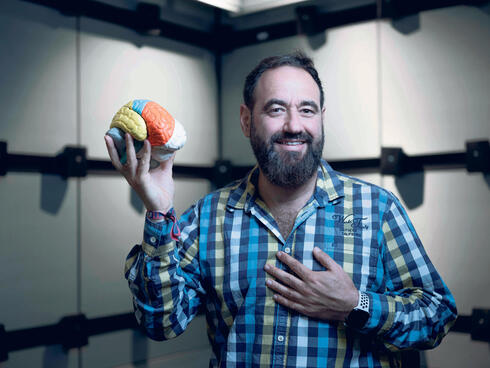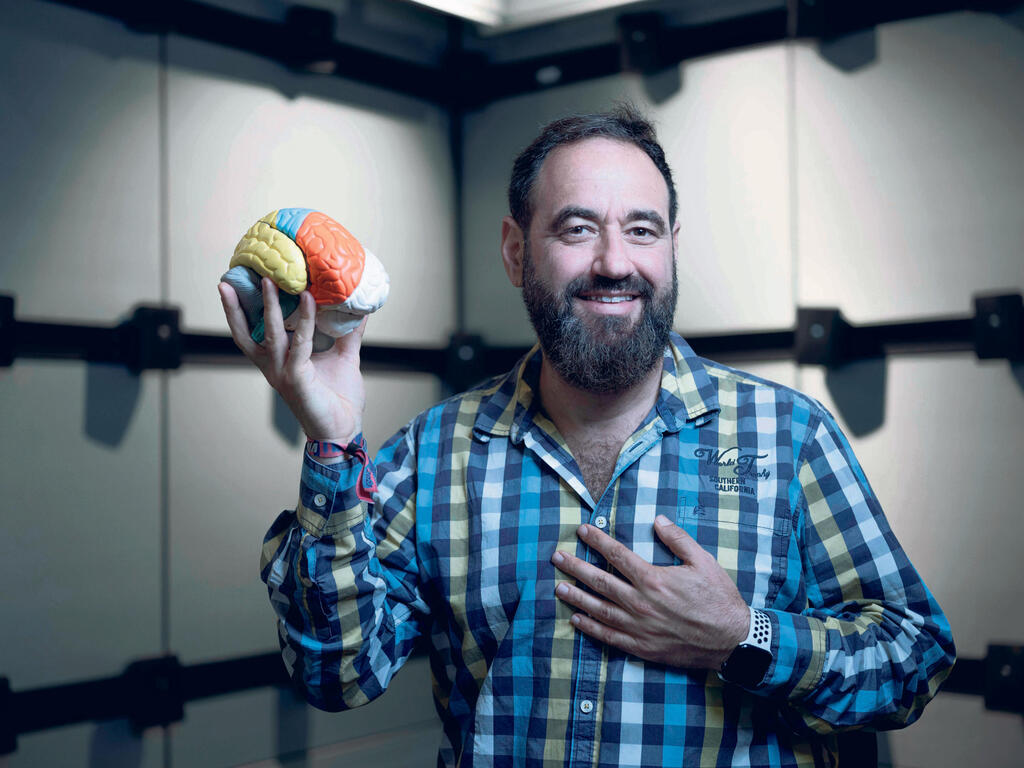
"Brain chips will give us super abilities in the future"
"The combination of artificial intelligence and a chip that can stimulate the brain opens an almost endless door of possibilities. The revolutionary potential is great and so are the dangers," says Prof. Amir Amedi, founding director of the Ivcher Institute for Brain, Cognition & Technology at Reichman University
In a groundbreaking development, Elon Musk's Neuralink has successfully implanted a human brain, marking a significant leap in brain-machine interface technology. Professor Amir Amedi, founding director of the Ivcher Institute for Brain, Cognition & Technology at Reichman University, believes this can be particularly beneficial for those with impairments, such as blindness or limb loss. While acknowledging ethical considerations, he envisions vast possibilities, including mood regulation and enhanced sensory capabilities. Despite the transformative potential, Amedi urges a balanced exploration of alternative, non-invasive approaches to understanding and influencing the brain.
Prof. Amir Amedi, founding director of the Ivcher Institute for Brain, Cognition & Technology at Reichman University, this week Elon Musk's Neuralink announced the implantation of the first chip in a human brain. How exciting is this news?
"It's joyful, innovative and exciting because everything that happens to us as humans that we experience, whether it's seeing, hearing, emotions or thoughts - results from electrical activity in the brain. What Neuralink's technology enables is to create electricity in the brain in unnatural ways. In principle, if everything is in order there is no reason to interface with the brain and introduce electricity into it, it is unnecessary and dangerous, but if there is a problem, for example in the case of blindness, or if the connection between the electricity and the hand area is damaged for some reason and you have a prosthesis, then this is a very important capability, this is also why Neuralink went in this direction (began the experiments on humans without four limbs). I don't think that's where they're headed but that's why they went there in the clinical trial. It is very important and interesting and it has a dramatic effect on the development of the field. On the other hand, Neuralink is not the first to use chips in humans. A chip was implanted in people with prostheses and the blind already in the 1970s, this is research that has been going on for several decades in different places. From this point of view, there is no breakthrough here."
So what is revolutionary about Neuralink?
"Neuralink's revolutionary approach exists on two levels: the first is that until today, to perform these surgeries, surgeons were needed, in complex surgeries that would have taken a long time. Neuralink has developed an innovative robotic technology that allows these surgeries to be performed automatically to a certain extent. And the vision is that the more automated this becomes, the more it will be able to scale, grow on a commercial level. The second level of innovation is related to artificial intelligence: the problematic part about implanting a chip is making sure that it injects electricity correctly to a certain part of the brain. For that, you need to know the neural code, so that when electricity passes, it will go to the right place and move the injured hand and not the leg, and do it in the right way. It's complicated and this is where artificial intelligence and machine learning come in, through which you can learn what the specific electrical pattern is across masses of neurons to move the hand to the right versus the hand to the left.
"This information can be given to the computer so that it learns the patterns and the best way to stimulate the brain. We are still at the beginning, but the beauty of the method is that you don't have to fully understand the code, but only see the difference between the patterns. It is also possible to program so that the same pattern does not move the hand to the right. Theoretically, it is possible to make a connection between different thoughts and different activities. You can interface with anything with the power of thought, that's why at Neuralink they also called this chip, from a clever marketing point of view, 'telepathy'."
So the implants mediate between thought and action, does that mean that a person with such an implant needs to constantly think about the next required action?
"There is something to it, but studies show that as these things are used more and more, it becomes more automatic. For example, in brain-computer interfaces, there is research that shows that without the chip, in an MRI, it is possible to record the electrical activity from the visual movement area, to imagine movement to the right and movement to the left. For example, you imagine up and down and a computer cursor goes up and down and that's how you play ping pong on the computer. There is a follow-up experiment in which people sat with two MRI machines and played ping pong against each other just by the power of thought. In the experiments they showed that the more you practice, the more automatic it becomes. What happens with the chip is that instead of recording it indirectly through the MRI, there will be a chip that sits on the cerebral cortex and records the electrical activity, so it's much faster and more accurate."
"Right move by Musk in terms of PR"
So apparently it is possible to increase our brain's existing capabilities as well?
"Neuralink made a strategic choice, they wouldn't have allowed them to do an experiment where they put a chip in a person and then they lose their appetite or answer the phone. Musk talks about it in his presentations but no one would have authorized them to do such a thing. Both in terms of public relations and in terms of FDA approvals. They chose a path to assist people with problems, from there maybe a path will be paved for other applications such as for example 'super vision'.
"Humans have the ability to see at wavelengths between 400 and 700 nanometers. Waves below 400 nanometers are infrared, which enables night vision. Suppose I insert a chip into the vision system, in the first stage it is connected to a normal camera of between 400 and 700 nanometers , the chip will stimulate the visual cortex of a blind person and create a sensation of light and vision. This is something we already know how to do in the laboratory today. What is the resolution and how much can you really see are additional questions. Today progress is very slow and the resolutions are very low, that's why Neuralink started with paralysis, not the vision. But if there is a chip in there that learns different patterns in machine learning, it is possible in principle to stimulate it so that it has infrared vision and has the ability to see hot things at night. Theoretically, this is an opening to super abilities, and the ability to interface with technology.
"When you look at it several decades ahead, there is a crazy revolution here. But you have to be careful because progress is slow. Theoretically, the potential of technology is almost infinite, there is a potential to interface with anything with the power of thought and thus create experiences for us with other people. It will take a lot more time until it becomes possible."
When similar tools of electrical stimulation were used for patients suffering from depression, there were various reports of changes in the experience of self. What can such technology, when advanced and tested enough, do to our self-identity?
"In the bottom line, an effect on the mental state, the experience of self, unity with the world, meaning, compassion and other things are very possible. When we look at the brains of depressed people, their electrical activity is different from the activity of a non-depressed person. There is a certain area in the frontal cortex that in depressed people is unbalanced between the right side and the left side. Too much activity on one side and too little activity on the other side. And if a chip can be inserted, the stimulation can be done at a higher resolution and it can be connected to artificial intelligence, which will help stimulate the individual person in the optimal way for them. Theoretically, there is huge potential here to also affect our mood. We want to be sad and be creative and create art, so we make ourselves sad and know that in an hour we can switch to a happy state. It sounds like science fiction, but it is no more difficult than moving fingers in a sophisticated way or restoring vision.”
"Infinite possibilities to stimulate the brain"
What about the moral aspect?
"The potential is great, but of course heavy ethical questions arise: What happens if I'm not depressed but just want the ability to influence my mood. Does this justify invasive surgery where I insert a chip into my brain? How does this affect my experience as a person and what happens if I want to lose 20 kilos and don't know how? We know very well the area of the brain that is responsible for the feeling of satiety and hunger, and it is theoretically possible to learn the electrical pattern of this mechanism through machine learning. A chip that sits there precisely and intelligently can ensure that after seven o'clock I will not experience a feeling of hunger. The combination of artificial intelligence and a chip that can stimulate the brain opens an almost endless door of possibilities. The revolutionary potential is great and so are the dangers."
You talk about AI solving the need to understand the code in high resolution, but that brings us to the black box problem of AI. Isn't it dangerous not to understand what the machine is doing?
"This is an important point. Most artificial intelligence experts say, 'I don't care how the machine learned, the main thing is that it moves the hand.' For this area, it makes it possible to activate undirected areas that interface with an area of the chip that will create something completely new. It can be scary, talking about emotions and the sense of self. When we talk about the activity in the brain and affecting the person here it is of great importance to understand the code. The technology itself can help us better understand the neural code and the brain."
Are there other alternatives?
"It will take many, many more years for technology to change the lives of most of the blind, and for the everyday person it will take much longer. Such technologies change brain activity, so it is true that there is something much more direct in using them, but much of the brain's healing potential is also possible in non-invasive form. It's a little more challenging but it's much safer, and it's important to say this too: we are very fascinated by the technology that allows us to put a chip in the brain but there are many more ways to change and heal, and we need to remember as a society - we scientists, technologists and entrepreneurs - that there are many ways to have an influence in a safe and fast way. That is why there is great importance in understanding the brain even under normal conditions, of a disease or a special condition, and there is not enough research in this area. We devote a fraction of our resources to these questions which are actually the most important to us. And that is why I am very ambivalent about Neuralink, but it does help to bring the importance of grasping the science of understanding the mind to the attention of the general public."














